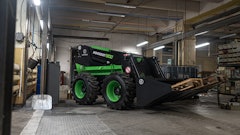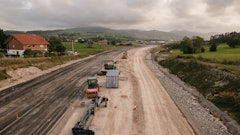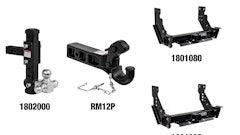
St. Francis Hospital in Indianapolis, IN, is in the midst of a $265 million expansion. Upon its completion by mid-year 2010, the hospital campus will have a new emergency room, six-story inpatient tower, surgical suites and additional space for support services.
As part of the expansion, Tonn and Blank (T & B) Construction Co., Michigan City, IN, the construction subsidiary of the Sisters of St. Francis Health Services, Inc., is installing a 30,000-gal. fiberglass fuel tank measuring 47 ft. long and 12 ft. in diameter. The tank will be used to fuel the hospital?s backup generators.
The excavation site was located about 6 ft. from the hospital. Nearby obstacles included a loading bay dock directly along one side that had to stay open throughout the excavating and installation process, and newly installed electrical banks just a few feet on the other side. As a result, excavators and other equipment could only access the site from two sides.
Slide rail proves the only option
Clearly, shoring the excavation to T & B?s strict safety standards was going to be a challenge. So Stan Burnside, T & B?s foreman, contacted Jim Wright, branch manager at United Rentals Trench Safety in Indianapolis.
?After looking at the specs of the project, I could see that our options were very limited,? admits Wright. Vibration restrictions at the hospital prevented the use of vibratory hammer-installed sheeting and bracing. ?Also, installing a beam and plate or lagging system was off the table due to the two week schedule given to complete the project.?
Wright contacted Scott Moreland, United Rental Trench Safety?s product install and shoring specialist, to discuss alternatives. ?When it was all said and done, a slide rail shoring system really was the best option for the tank installation,? Wright says. ?It was the most cost-effective system for the job.?
However, Burnside required some convincing. ?When Jim first suggested slide rail, I was a bit skeptical because I wasn?t at all familiar with it, and it didn?t sound anything like other shoring systems I?ve used,? he comments. ?But Jim did a great job explaining to me what it is, its advantages and how it works.?
After designing a slide rail shoring plan, Efficiency Production in Mason, MI, was contacted for proposal drawings for a three-bay, four-sided Multi-Bay slide rail system that would allow T & B to completely shore an unobstructed pit measuring 56 ft. long, 16 ft. wide on the ends, down to a depth of 16 ft. A Parallel Beam cross-trench support design incorporating external ClearSpan waler I-beams enabled an unobstructed opening of more than 55 ft.
Efficiency?s Universal Slide Rail is a component shoring system comprised of steel panels, similar to trench shield sidewalls, and vertical steel posts that can be used in a variety of configurations. The system is installed as the trench or pit is excavated by sliding the panels into integrated rails on the posts, then pushing the panels and posts incrementally down to grade as the pit is dug. It is installed and removed incrementally, allowing the trench to be properly shored and safe for workers throughout the entire installation or removal process.
Problem-free installation
T & B began the excavation by first cutting a roughly 6-ft.-deep pilot hole on the end nearest to the hospital and laying in an 8-ft.-tall, 20-ft.-wide panel. The 18-ft.-long slide rail corner posts were then set on both ends by sliding the posts outside slotted rail, down a ?t-track? welded on the panel ends. Two more 8-ft. panels were installed perpendicular to the first panel, this time by sliding the panels? t-tracks down the corner posts? other set of outside slotted rails, which are 90° to the first.
Along one side of the trench, electrical banks had been recently installed, so the soil was primarily heavily saturated fill sand. Water almost immediately began flowing into the pilot hole, and had to be controlled by pumps while installing the slide rail components. And while the side with sand was very unstable, directly across the pit was hardpacked clay. Fortunately, the slide rail system is designed to work in both types of soil conditions.
After the three panels were set in a U-shape, footprinting the first ?bay,? the first Parallel Beam-Linear Post Assembly was set on the ends of the open panels. This cross-trench support, unique to the Efficiency system, is designed with special parallel beams that pin in place the standard trench shield spreader pipes. The parallel beams have rollers that allow them to be removed, creating an unobstructed, shored excavation.
To reach 16 ft. deep, the panels and posts were pushed incrementally until a depth of 8 ft. was accomplished. More 8-ft.-tall panels were then installed into the posts? inside open-face rails, and were pushed incrementally until the entire first bay was at grade. The second and third bays were installed in a similar manner. Once the entire system was at grade, level and backfilled with stone, T & B poured-in-place the tank?s concrete foundation.
Quick completion
After the ClearSpan waler beams were secured in the integrated brackets that slide down the outside face of the linear posts, the three parallel beam-spreader assemblies were removed for the tank set. This resulted in a 56-ft.-long unobstructed pit that was was able to accommodate the 47-ft.-long tank. The tank was set with a crane and backfilled with stone, while the slide rail components were pulled incrementally from the ground.
?[The slide rail system] really met my expectations,? says Burnside. ?As we were taking the system out of the ground, I thought to myself that I can use this [system] on another excavation project coming up in a few months. In fact, I wish I knew about this earlier, because it would have worked great on some other utility projects here at the hospital that we?d already completed.?
For more information, visit www.ForConstructionPros.com


























